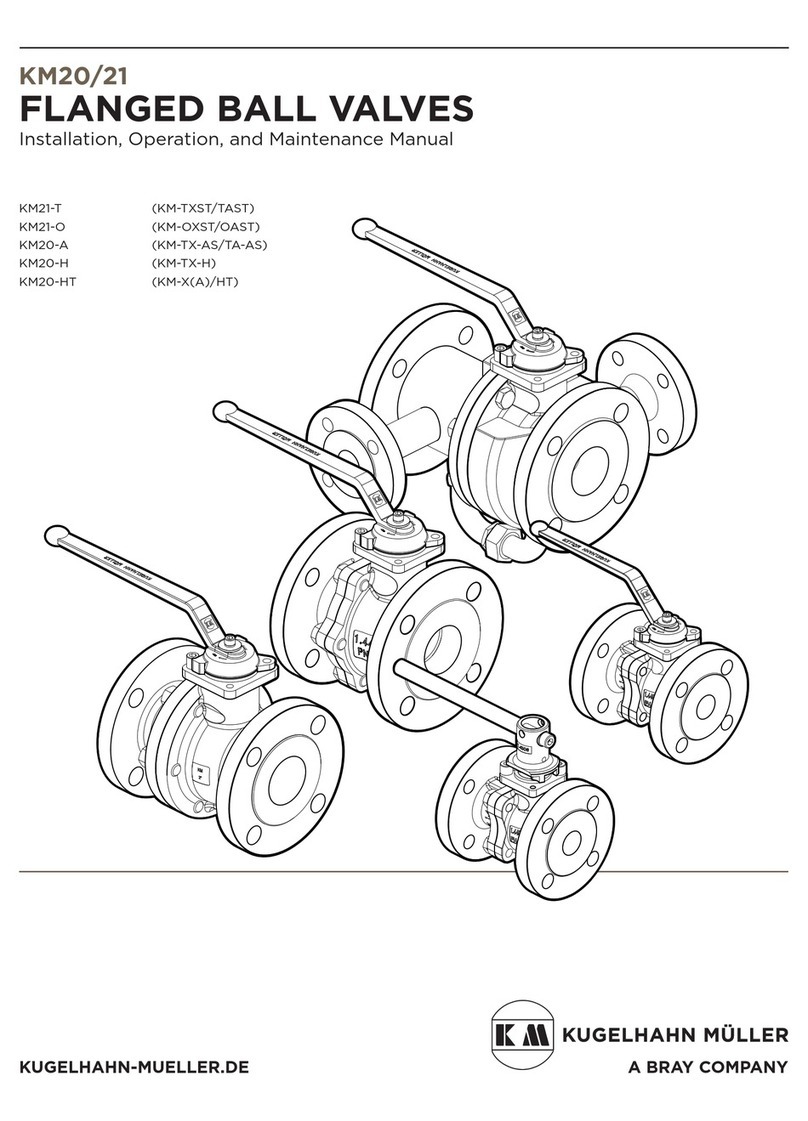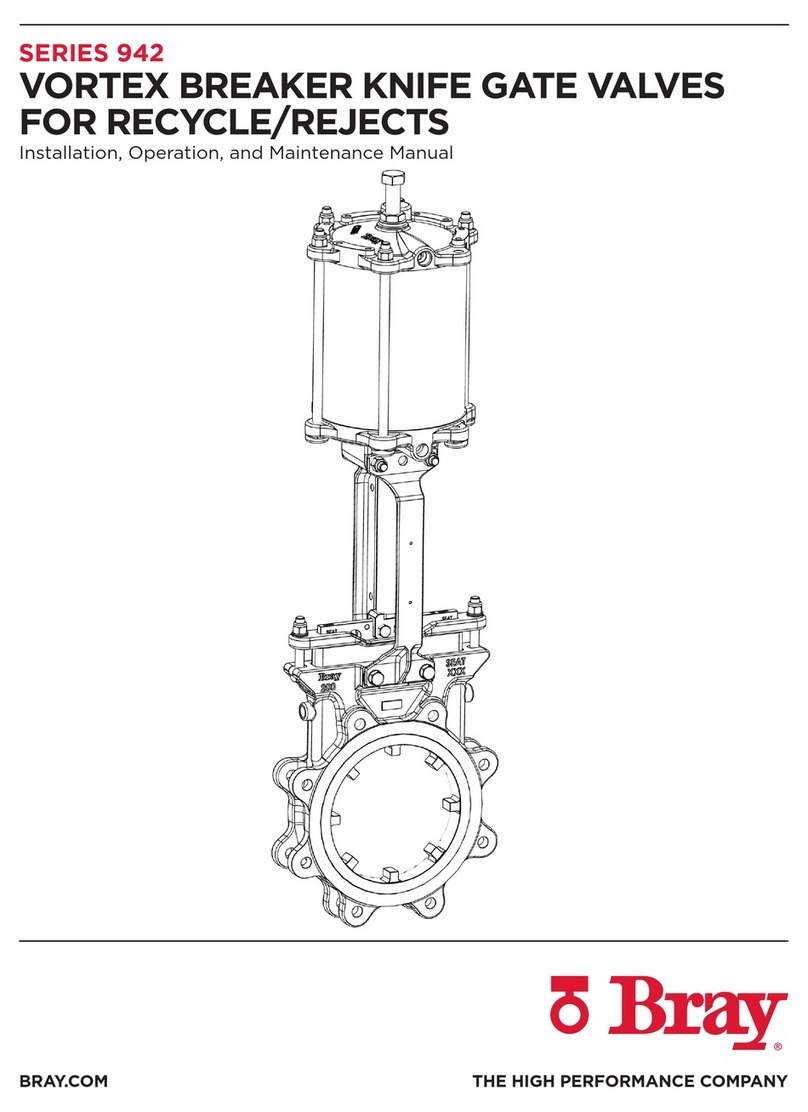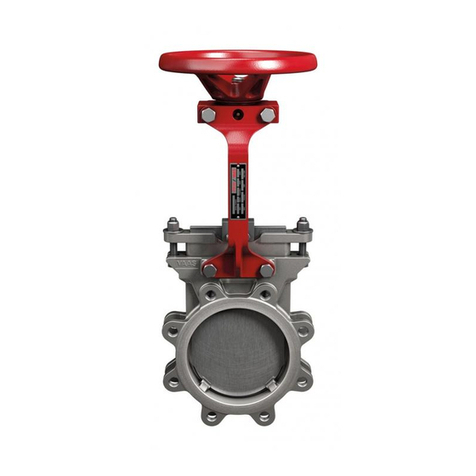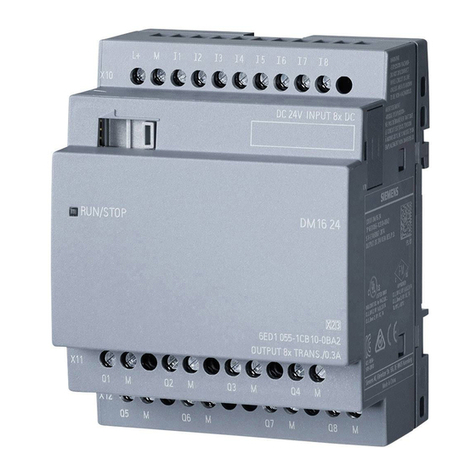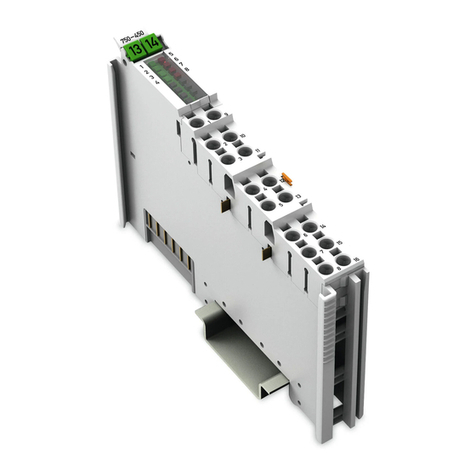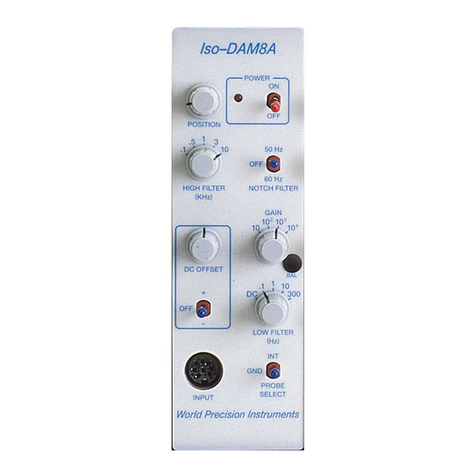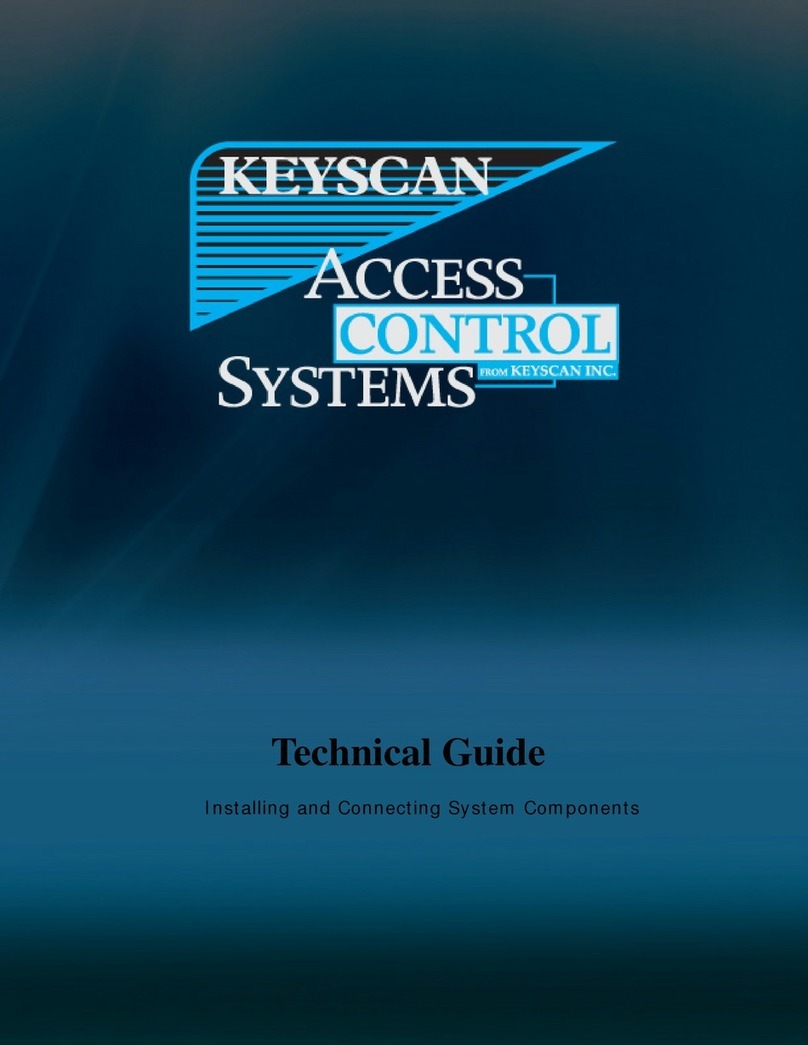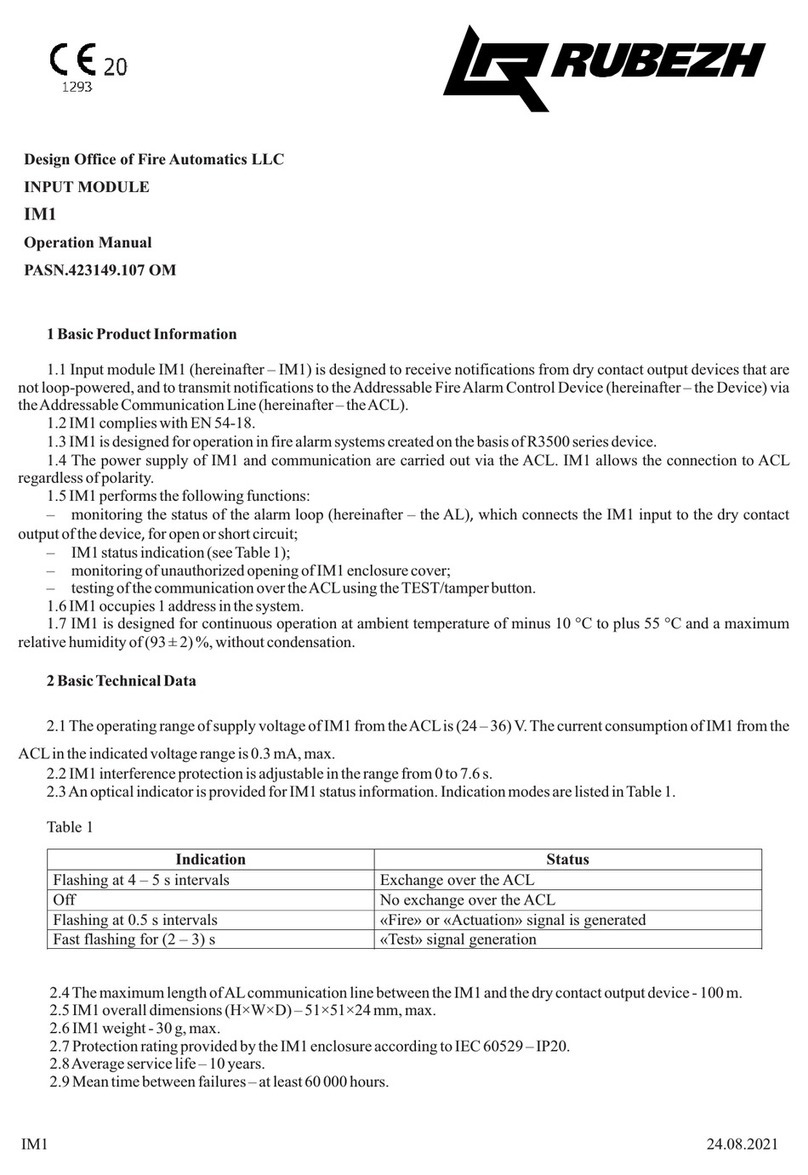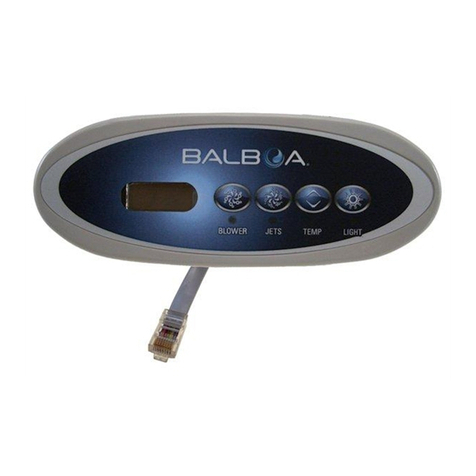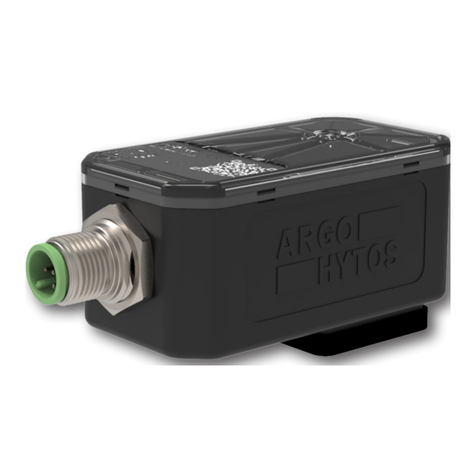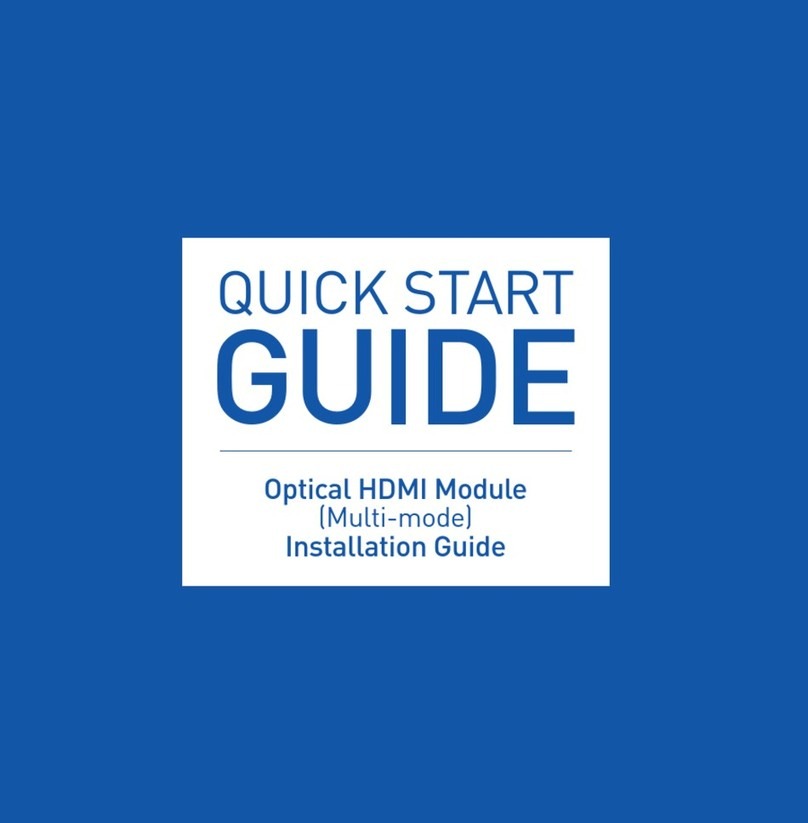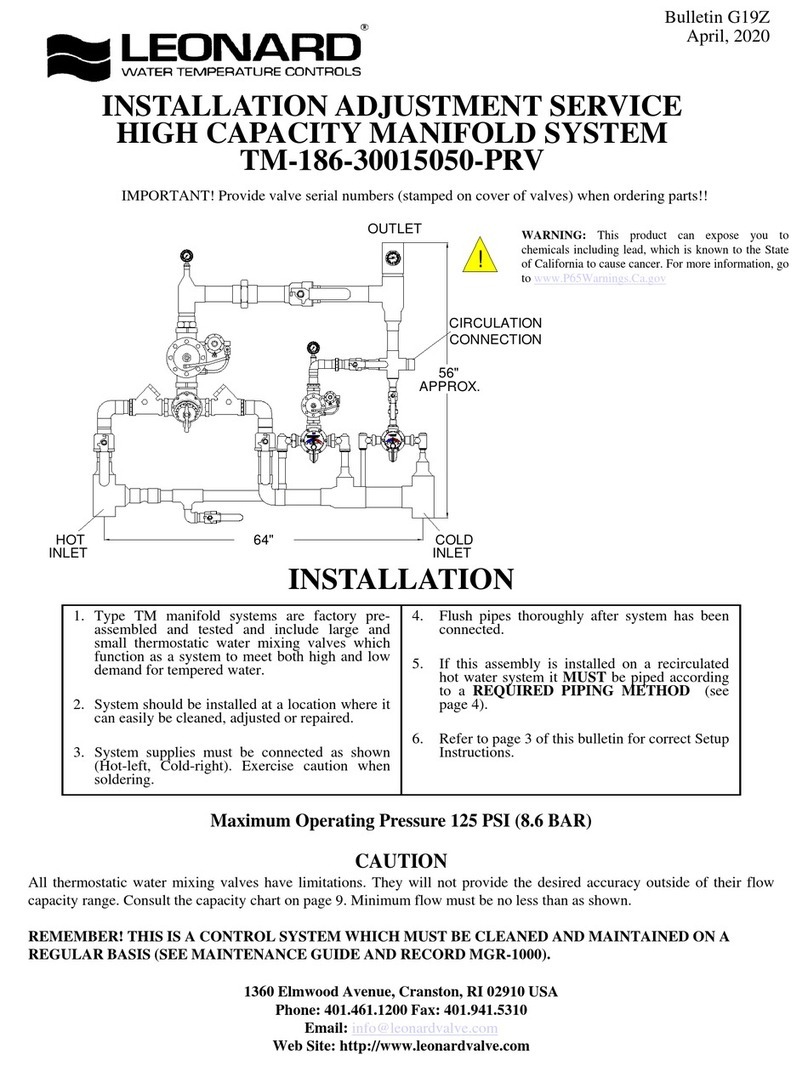Bray TRI LOK User manual

The
High
Performance
Company
TRI LOK
TRIPLE OFFSET VALVE
OPERATION AND MAINTENANCE MANUAL


1
BRAY Tri Lok Triple Offset Valve
Operation and Maintenance Manual
Table of Contents
1.0 Safety Information .........................................................................................2
1.1 DenitionofTerms ........................................................................................2
1.2 ATEXDirective94/9/EC ...............................................................................2
2.0 Introduction....................................................................................................3
3.0 Installation......................................................................................................3
3.1 Table1:Min.AllowablepipeIDforInstallation...........................................4
4.0 Maintenance...................................................................................................5
4.1 StemSealReplacement..................................................................................5
4.2 Table2:No.ofStemSeals&TorqueValuesforGlandRetainingUnits ......5
4.3 BodySeatReplacement .................................................................................6
4.4 DiscSealRingReplacement..........................................................................7
4.5 Table3:TighteningTorqueValues
ForIndividualBodySeats&DiscSealRings...............................................9
5.0 CompleteValveDisassembly.........................................................................9
6.0 ValveAssembly............................................................................................10
7.0 ValvePartDiagram ......................................................................................11
FOR MORE INFORMATION ON THIS PRODUCT AND OTHER BRAY PRODUCTS
PLEASE VISIT OUR WEBSITE – www.bray.com

2
BRAY Tri Lok Triple Offset Valve
Operation and Maintenance Manual
1.2 ATEX DirEcTivE 94/9/Ec
WARNING
When using this product in hazardous environments,
the national directives and laws which apply in your
country for hazardous areas must be followed. The
specications of the examination certicate valid in
country of operation must be also observed.
1.2.1 MArking
Certificate Number: LRVL 10ATEX0003X
Certification Code:
Non-Mining Applications
0038 II 1 G c
Mining Applications
0038 I M1 c
Ambient Range: TX See Special Conditions for Safe Use
Serial Number: As appropriate
Year of Manufacture:
Warnings:
1.2.2 Sp EciAlconDiTionS for SAfE USE
The following factors must be carefully considered in
order to ensure the valve is compatible with the atmosphere
in which it is applied. The system designer and/or end
user should be formally address each item and carefully
document the reasoning behind specic measures taken
to ensure continued compliance throughout the life of
the Tri Lok valve.
MATEriAlconSiDErATionS
Titanium is not to be used in Group I, mining applications
due to the potential of ignition due to mechanical sparks
from impacts such as a spanner being dropped on the
valve. Please see ES11A-0736 for details regarding
material limitations.
TEM p ErATUrE conSiDErATionS
The surface temperature of the Tri Lok valve is wholly
dependent onthe ambient temperaturein combination with
the temperature of the process medium. The maximum
surface temperature of the Tri Lok valves may be calcu-
lated from the maximum ambient temperature plus the
maximum process medium temperature as shown below:
Equation 1 - Surface Temperature Calculation
Ts(max) = Ta(max) + Tp(max)
The system designer is responsible for ensuring the
maximum temperature, either inside the valve body or on
the external surface, will remain well below the ignition
temperature of the atmosphere. Additional protective
devices may be required to ensure a sufcient thermal
safety margin, including but not limited to: thermal shut-
off devices, cooling devices.
STATic ElEcTriciTy conSiDErATionS
Where the process medium is a liquird or semi-solid
material with a surface resistance in excess of 1 G-ohms,
special precautions should be taken to ensure the process
does not generate electro-static discharge. This may be
done through ensuring the ow rate of the process media
remains below 1 m/s or providing sufcient discharge
1.0 Safety InformatIon
1.1 DEfiniTion of TErM S
WARNING indicates a potentially hazardous situation which, if not avoided, could result
in death or serious injury.
CAUTION indicates a potentially hazardous situation which, if not avoided, may result in
minor or moderate injury.
NOTICE
used without the safety alert symbol indicates a potential situation which, if
not avoided, may result in an undesirable result or state, including property
damage.
!
!
!

3
BRAY Tri Lok Triple Offset Valve
Operation and Maintenance Manual
points along the process path to eliminate electro static
build-up. Consultation to EN 50404 is recommended.
Appropriate grounding may be necessary through the
use of grounding straps or other means.
STrAy ElEcTric cUrrEnT conSiDErATionS
Where the Tri Lok valve is used near sources of high cur-
rent or magnetic radiation, provisions shall be made to
ensure a secure bonding to earth ground so as to prevent
ignition due to inductive currents or a rise in temperature
due to these currents.
filTrATion of procESS MEDiUM
conSiDErATionS
Special consideration should be made regarding the l-
tration of the process medium if there is a potential for
the process medium to contain solid particulates. The
process medium is recommended to be ltered to allow
particles no greater than 1.0 mm in diameter through the
valve assembly where there is a high probability of solid
particulates. Larger particulate sizes may be deemed ap-
propriate based on the possibility of particulates within
the process medium and the area classifcation. The deci-
sion regarding ltration levels and limits should be well-
documented by the system designer and/or end user to
ensure continued compliance through the life of the valve.
2.0 inTroDUcTion
This manual covers Tri Lok valves in the following range:
ASME Classes: 150 and 300
Sizes: 3” - 24” (800 mm - 600 mm)
Body Style: Wafer, Lug, Double Flange and
Gate face-to-face conguration
The Bray Tri Lok metal seated valve is fully rated to
ASME B16.34.
The design of the valve complies with ASME B16.34
and API 609.
Tri Lok is torque-seated. Torque must be continually ap-
plied by an actuation device (manual gearbox or power
valve actuator) to the valve stem to ensure the valve seals
against the line pressure.
WARNING
Do not remove or de-energize actuation devices while
the valve is under line pressure.
The valve is inherently re safe, and has been qualied
to ISO 10497 and API 607, fth edition standards.
Tri Lok is suitable for bi-directional zero leakage tight
shutoff. More actuation torque is required to seal the
valve in the non-preferred direction.
The preferred direction of valve installation is with the
upstream line pressure on the stem side and the body seat
on the downstream side. The non-preferred direction of
valve installation is with the upstream line pressure on
the body seat side and the stem on the downstream side.
The preferred direction of ow is indicated by an arrow
on the valve nameplate.
3.0 inSTAllATion
1. Tri Lok is designed to be installed between ASME
B16.5 and ISO 7005 anges. When the valve is open,
a portion of the disc may protrude into the pipe. Wafer
and lug congurations will protrude on both sides
of the valve. In the double ange version and some
gate sizes, the open disc may protrude into the pipe
on the seat side of the valve. Adjacent piping must be
large enough to allow the open disc to clear the pipe.
Table 1 ( Pg. 4 ) shows both the minimum allowable pipe
ID and standard pipe ID. In general, Class 150 valves
will clear Schedule 40 pipe, and Class 300 will clear
Schedule 80 pipe adequately.
2. The valve closes with clockwise rotation of the stem,
and opens with counterclockwise rotation.
CAUTION
Avoid uncontrolled rotation of the disc beyond
fully-open position (counterclockwise) as this could
damage the sealing surfaces.
Over-rotation into closed position (clockwise) is not
possible, as the disc will stop against the seat in the
normal operating manner.
!
!

4
BRAY Tri Lok Triple Offset Valve
Operation and Maintenance Manual
3. To benet from the most favorable low operating torque
and best sealing conditions, install the valve with the
stem on the upstream (pressure side) of the installation.
The valve tag is marked with an arrow indicating the
preferred direction of the ow in the line.
4. Whenever possible, install the Tri Lok with the stem
in horizontal position with respect to the ground. If
this installation is not possible, Bray recommends
orienting the stem at an inclined angle with respect
to the ground,with the actuator above the horizontal
centerline. This will prevent process debris from ac-
cumulating in the stem bearing area. In addition, with
the valve stem horizontal, the weight of the disc will
be supported along the full length of bearing journals.
These positions will minimize operational wear.
5. Flange gaskets should conform to the requirements
of ASME B16.20 (supersedes API Standard 601) for
ASME B16.5 anges. Spiral wound gaskets, such as
Flexitallic® CG or CGI series, conforming to ASME
B16.20 are recommended.
6. When bolting the valve into the line, use standard
bolting torque as recommended by respective piping
standards. The valve body seat is independent of the
ange bolting, hence additional force from the ange
bolts is not required.
Notes for Table 1:
a. Minimum allowable ID of pipe with recommended
clearances (per API 609) have been calculated by
adding the minimum recommended diametric clear-
ance to the larger chordal dimension of the disc at
the valve face.
b. This table assumes that the valve is perfectly centered
in the pipe anges.
c. A minimum of 1/16” (1.6 mm) thick gasket is used
between the pipe ange and the face of the valve body.
d. When using a pipe whose ID is smaller than the
recommended minimum allowable ID of pipe with
adequate clearance, a spacer of appropriate thickness
and a proper gasket could be used at the ange face
to clear the disc. Alternately, for butt-welded pipe
anges, a 45 degree chamfer of required size to clear
the disc edge could be provided. Chamfering which
would cut into the internal weld at the ange ID is
not allowed in slip-on pipe anges.
TAb lE 1 - MiniM UM AllowAb lE p ip E iD for Tri lok inSTAllATion -
STAnDArD p ip E iD givEn for rEfErEncE.
Valve Size
Pipe Size
In (mm)
Min. Pipe ID.
Class 150
In (mm)
Min. Pipe ID.
Class 300
In (mm)
Nom. Pipe ID.
Schedule 40
In (mm)
Nom. Pipe ID.
Schedule 80
In (mm)
Nom. Pipe ID.
Schedule 100
In (mm)
3 (80) 2.0 (50.8) 2.0 (50.8) 3.1 (77.9) 2.9 (73.7) -
4 (100) 3.1 (77.7) 3.1 (77.7) 4.0 (102.3) 3.8 (97.2) -
6 (150) 5.0 (127.8) 4.8 (120.7) 6.1 (154.1) 5.8 (146.3) -
8 (200) 6.8 (171.7) 6.5 (164.6) 8.0 (202.7) 7.6 (193.7) 7.4 (189.0)
10 (250) 8.7 (220.5) 8.6 (218.9) 10.0 (254.5) 9.6 (245.2) 9.3 (236.6)
12 (300) 10.6 (270.0) 10.9 (276.9) 11.9 (303.2) 11.4 (289.0) 11.1 (281.0)
14 (350) 11.8 (300.0) 11.6 (293.9) 13.1 (333.3) 12.5 (317.5) 12.1 (308.0)
16 (400) 13.8 (349.5) 13.2 (335.0) 15.0 (381.0) 14.3 (363.6) 13.9 (354.0)
18 (450) 15.5 (392.4) 15.0 (380.7) 17.0 (428.7) 16.1 (409.6) 15.7 (398.5)
20 (500) 17.7 (450.3) 16.8 (427.2) 18.8 (477.9) 17.9 (455.6) 17.4 (442.9)
24 (600) 21.1 (539.9) 20.7 (526.5) 22.6 (574.7) 21.6 (547.7) 20.9 (531.8)
*See Notes below

5
BRAY Tri Lok Triple Offset Valve
Operation and Maintenance Manual
4.0 MAinTEnAncE
WARNING
Reasonable precaution should be taken before begin-
ning any work on the valve.
Protective clothing, as required by specic line uid
and appropriate safety codes, should be worn.
Depressurize the line and close the valve before
removing the actuation device from the valve.
Depressurize the line before loosening any packing
gland nuts.
Do not pressurize the line without an actuation device
properly installed and working on the valve.
CAUTION
The Tri Lok valve must be in closed position to be
removed from the line. Otherwise, the sealing edge
could be damaged.
1. When replacing the body seat and/or disc seal ring
with the valve in the line in dead-end installation,
or with the piping on the body seat side removed,
depressurize the line and marginally crack-open the
disc before loosening any of the valve trim fasteners.
2. Begin all work on a valve that has been removed from
the line by cleaning the valve, removing any grit or
scale. When handling the valve, care should be taken
not to scratch the disc seal ring, the body seat, and
gasket faces on both sides of the valve.
3. Replacement body seats, disc seal rings, and other
parts are available from authorized distributors.
Contact your Bray distributor or sales representative
for details on price and delivery.
4.1 STEM SEAlring rEp lAcEM EnT:
Refer to the parts diagram for parts identication by
reference numbers in parentheses. ( Pg. 13 )
1. If the valve is installed in the line, depressurize the
line. Remove operator or actuator from the valve.
Remove socket head cap screws and lock washers
(25). Remove mounting bracket or mounting plate
(26), depending on valve size. Note assembly posi-
tions of the operator or actuator and the mounting
hardware for subsequent reinstallation.
2. Remove packing gland retainer nuts (24) and lock
washers (23). Remove gland retainer (22), anti-
blowout retaining ring or split ring (21) depending
on valve size and gland ring (19).
3. Extract all stem seals (18A and 18B), taking care not
to scratch the stem or the bore of the stufng box.
!
TAb lE 2. - nUM b Er AnD Typ E of STEM SEAlringS AnD TorqUE vAlUES
for glAnD rETAining nUTS.
Valve Size
in (mm)
Number of Rings
Class 150
Number of Rings
Class 300
Gland Nut Torque
Class 150
lb-in. (Nm)
Gland Nut Torque
Class 300
lb-in. (Nm)
3 (80) 2 B plus 2 F 2 B plus 2 F 35 (4.0) 45 (5.1)
4 (100) 2 B plus 2 F 2 B plus 2 F 35 (4.0) 45 (5.1)
6 (150) 2 B plus 2 F 2 B plus 2 F 45 (5.1) 65 (7.3)
8 (200) 2 B plus 2 F 2 B plus 2 F 45 (5.1) 80 (9.0)
10 (250) 2 B plus 2 F 2 B plus 2 F 65 (7.3) 100 (11.3)
12 (300) 2 B plus 2 F 2 B plus 2 F 65 (7.3) 100 (11.3)
14 (350) 2 B plus 4 F 2 B plus 6 F 80 (9.0) 125 (14.1)
16 (400) 2 B plus 4 F 2 B plus 7 F 100 (11.3) 150 (16.9)
18 (450) 2 B plus 7 F 2 B plus 7 F 100 (11.3) 150 (16.9)
20 (500) 2 B plus 7 F 2 B plus 8 F 100 (11.3) 150 (16.9)
24 (600) 2 B plus 8 F 2 B plus 6 F 150 (16.9) 200 (22.6)
B = braided carbon yarn packing stem seal ring, F = solid formed graphite stem seal ring.
!

6
BRAY Tri Lok Triple Offset Valve
Operation and Maintenance Manual
Do not remove the thrust washer (17) unless further
valve disassembly is required.
4. Examine the stufng box bore and the stem and clean
as necessary to remove any corrosion or foreign mat-
ter before installing new stem seals.
5. Install new stem seals in stufng box one at a time.
The number and type of stem seal rings for individual
valve sizes and pressure class are listed in Table 2.
Insert bottom braided packing ring stem seal (18A)
into the stufng box. The splice in this ring has to
be oriented perpendicular to ow direction. Using
packing tube, tamp the braided packing ring stem
seal rmly into position.
6. Insert all solid graphite stem seal rings (18B). If the
rings are not endless, stagger splices at 180 degrees
intervals, making sure the splices remain located
perpendicular to the ow direction. Use a packing
tube to set individual rings rmly, but without exces-
sive effort as not to crush the graphite.
7. Insert top braided packing ring stem seal ring (18A)
into the stufng box. The splice in this ring must be
oriented perpendicular to the ow direction, and at
180 degrees to the splice in the ring immediately
below. Using a packing tube, tamp the top ring rmly
into position.
8. Reinstall gland ring (19), anti-blowout retaining ring
(21) and gland retainer (22). Re-install lock washers
(23) and nuts (24). Tighten gland nuts (24) evenly and
alternately to the proper torque value given in Table 2.
9. Reinstall mounting bracket or mounting plate (26)
with cap screws and lock washers (25). Remount
actuation device on top of the valve.
10. Operate the valve open and closed several times
to check for binding and to set the stem seal rings.
Loosen gland nuts (24) and retighten to torque value
given in Table 2.
4.3 boDy SEAT rEp lAcEM EnT:
Refer to the parts diagram for parts identication by
reference numbers in parentheses. ( Pg. 13 )
Bray recommends that both the body seat (8) and the disc
seal ring (13) be replaced at the same time. However,
individual components are not matched in pairs and can
be replaced separately if desired.
CAUTION
Exercise extra care when handling the body seat and
disc seal ring to avoid damage to the sealing areas.
Close the valve and remove the operator or actuator
as applicable. Place the valve on a at stable surface,
with the body seat (8) facing up.
1. Carefully cleanthe surface ofthe body seatand remove
all foreign matter from the hex sockets of the seat
retaining cap screws (9). Blow out the gap between
the body seat OD and the wall of the retaining cavity
in valve body (6). Apply a suitable penetrant (WD40,
etc.) into the gap between the body seat OD (8) and
the body (6) to help in extracting of the body seat
(8) from the body cavity.
2. Using a suitable wrench, remove all body seat retain-
ing socket cap screws (9).
3. Using a hard wood or aluminum drift and a light
hammer, tap the top of the body seat (8) lightly all
around to loosen the body seat in the retaining cavity.
4. Using full-threaded bolts or suitable threaded rod
matched to the threads in all tapped jacking holes,
commence jacking the body seat (8) evenly out from
the retaining cavity. Tap the body seat lightly with
the drift as necessary to keep it in alignment with the
walls of the retaining cavity in the body (6) while
jacking. Remove the body seat (8) from the body (6).
Table 3 lists the thread sizes of jacking bolts for individual
valve sizes. ( Pg. 9 )
5. Using soft tools and suitable wire brush, carefully
clean any remnants of old gasket and foreign matter
within the retaining cavity. Blow out all threaded
holes and gasket grooves with compressed air.
6. Remove the disc seal ring retaining screws (10) and
lock washers (11) from the disc seal ring retainer
(12). Remove the disc seal ring retainer (12). If the
old disc seal ring (13) is to be reinstalled, extract it
carefully. Wipe the disc seal ring (13) clean, removing
!

7
BRAY Tri Lok Triple Offset Valve
Operation and Maintenance Manual
all remnants of old gasket and foreign matter. Place
the old disc seal ring (13) aside for reinstallation
(if not replacing the disc seal ring with a new one).
7. Using soft tools and suitable wire brush, carefully
clean any remnants of old gasket and foreign matter
from the face of the disc (15). Blow out all threaded
holes and the gasket groove with compressed air.
8. Place a new disc gasket (14) into the groove on the
disc face (15). The mating side of the disc gasket can
be lightly sprayed with adhesive to improve retention
in the groove. Place the disc seal ring (13) onto the
disc, making sure the alignment line on the disc seal
ring matches the locating dimple in the disc face.
Place the disc seal retainer (12) over the disc seal
ring. Apply anti-seize compound to the disc seal ring
retaining cap screws (10). Install all disc seal ring
retaining cap screws (10) with lock washers (11).
The disc seal retaining cap screws (10) should to
be fully threaded into the disc (15), but remain only
nger-tight at this time.
9. Place the body seat gasket (7) into the groove in the
body seat (8). It is highly recommended to apply a
light lm of spray adhesive to the mating side of the
body seat gasket to secure its position in the groove.
Apply a suitable lubricant to the sealing surfaces of
the body seat (8) and disc seal ring (13). Insert the
body seat (8) into the body (6) over the disc seal
ring (13), making sure the alignment dimples in the
body seat (8) and the retaining cavity in the body
(6) both match. Apply anti-seize compound to body
seat retaining cap screws (9) and install the screws
(9) nger-tight.
10. Verify that all four alignment marks match (body,
body seat, disc seal ring and disc seal ring retainer)
and then tighten the body seat retaining cap screws
(9) evenly and rmly using a crisscross pattern when
tightening. The tightening torque is specied in the
Table 3 (Pg. 9).
11. Using a suitable wrench at the end of the splined stem
(5), partially open and quickly close the disc (15)
seating it rmly into the body seat (8) a few times.
12. Close the valve. Tighten all the disc seal ring retainer
screws (10) using a crisscross pattern. Tighten all the
disc seal retainer screws (10) to the torque specied
in Table 3 (Pg. 9).
13. Re-apply lubricant to the sealing surfaces of the valve.
Reinstall actuation device and test the valve.
4.4 DiSc SEAlring rEp lAcEM EnT:
Refer to the parts diagram for parts identication by
reference numbers in parentheses.
Bray recommends that both the disc seal ring (13) and
the body seat (8) be replaced at the same time. However,
individual components are not matched in pairs, and can
be replaced separately.
CAUTION
Exercise extra care when handling the body seat and
disc seal ring to avoid damage to the sealing areas.
The disc seal ring (13) can only be replaced in two ways:
replacing the disc seal ring (13) without removing the
body seat (8); or replacing the disc seal ring (13) with
the body seat (8) removed.
To remove the disc seal ring (13) without removing the
body seat (8) requires the valve actuation device be re-
moved from the valve and the valve ipped over to allow
access to both sides of the valve. For that reason, this
procedure is not suitable for occasions where the disc
seal ring (13) needs to be replaced in a valve installed
in the pipeline. In addition, this procedure is not recom-
mended for large Tri Lok valves where ipping the valve
over may be more difcult than removing the body seat
(8) and installing the disc seal ring (13) solely from the
body seat side.
Disc Seal Ring replacement with the Body Seat in
the valve:
1. Remove the valve from the pipeline. Remove the
actuator or operator from the valve.
2. Clean the surface of the valve, blow out all debris
around the disc seal ring retainer (12) and clean out
the hex sockets of the disc seal ring retaining cap
screws (10).
!

8
BRAY Tri Lok Triple Offset Valve
Operation and Maintenance Manual
3. Loosen up all the disc seal ring retaining cap screws
(10), but leave them in the valve with the disc seal
ring retainer (12) attached to the disc (15).
4. Using a suitable wrench, rotate the valve splined
stem (5) counterclockwise passed the fully open
position far enough only such that the disc is in a
position that will facilitate extraction of the disc
seal ring retainer (12) and the disc seal ring (13). Be
careful not to over-rotate the splined stem (5) to the
point where the disc seal ring (13) or disc edge (15)
would contact the body (6). Make sure the packing
gland retainer nuts (24) are tight enough to prevent
the valve splined stem (5) to rotate on its own under
the eccentric weight of the disc (15).
5. Remove the disc seal ring retaining cap screws (10)
and lock washers (11), and extract the disc seal ring
retainer (12) and the disc seal ring (13).
6. Rotate the disc (15) as necessary to access the seal
face on the disc (15). Using soft tools and suitable
wire brush, carefully clean any remnants of old gasket
and foreign matter from the face of the disc (15).
Blow out all threaded holes and the gasket groove
with compressed air.
7. Rotate the disc (15) back to the position required to
facilitate installation of the disc seal ring (13). Place
a new disc (15) seal ring gasket (14) into the groove
on the disc face (15). The mating side of the disc seal
ring gasket can be lightly sprayed with adhesive to
improve retention in the groove. Place the disc seal
ring (13) onto the disc (15) making sure the alignment
line on the disc seal ring matches the locating dimple
in the disc face. Place the disc seal ring retainer (12)
over the disc seal ring. Apply anti-seize compound
to the disc seal ring retaining cap screws (10). Install
all retaining cap screws (10) with lock washers (11).
The cap screws (10) need to be fully threaded into the
disc (15), but remain only nger-tight at this time.
8. Lubricate the sealing surfaces of the disc seal ring
(13) and the body seat (8). Using a suitable wrench,
rotate the valve splined stem (5) clockwise until the
disc seal ring (13) approaches closed position. Do
not force the disc seal ring (13) into the body seat (8).
9. Flip the valve over such that the seat side faces upward.
Verify that all four alignment marks (body, body seat,
disc seal ring, disc seal ring retainer) are aligned (i.e.
verify that the body seat (8) and disc seal ring (13) are
in proper positions). Using the wrench, slowly rotate
the disc (15) into the body seat (8) making sure that
the sealing edges line up properly without binding.
The disc seal ring retaining cap screws (10) should
still be only nger tight at this time.
10. Using a suitable wrench at the end of the splined stem
(5), partially open and quickly close the disc (15)
rmly into the body seat (8) a few times. Close the
valve. Tighten the disc seal ring retainer cap screws
(10) using a crisscross pattern. Occasionally open and
quickly close the valve while tightening the disc seal
ring retainer cap screws (10) to the torque specied
in the Table 3 (Pg. 9).
11. Re-apply lubricant to the sealing surfaces of the valve.
Reinstall operator or actuator and test the valve.
Disc Seal Ring replacement with the Body Seat re-
moved from the valve:
This procedure follows the procedure for replacing the
body seat (8) described above. If the old body seat (8) is
to be reused, exercise extra care when extracting it from
the retaining cavity in the valve body (6). When using the
jacking bolts to extract the body seat, avoid forcing the
jack screws unevenly which could result in permanent
deformation (pretzel twist) of the body seat (8). If the
old body seat (8) is to be reused, make absolutely certain
that the body seat (8) slides out of the retaining cavity
easily in a balanced and level manner.

9
BRAY Tri Lok Triple Offset Valve
Operation and Maintenance Manual
5.0 coM p lETE vAlvE DiSASSEM b ly:
1. Refer to the parts diagram for parts identication by
reference numbers in parentheses.
2. Close the valve. As applicable, remove operator or
actuator from the valve. Remove socket head cap
screws and lock washers (25). Remove mounting
bracket or mounting plate, (26) depending on valve
size. Note assembly positions of the operator or
actuator and the mounting hardware for subsequent
re-installation.
3. Clean all surfaces of the valve and blow out any loose
debris and foreign matter. Place the valve on a at
stable surface, with the body seat (8) side facing up.
4. Remove the body seat (8), following the procedure
described above in the section “Body Seat Replace-
ment”.
5. Remove disc seal ring retainer (12) and disc seal
ring (13) following the relevant portion of the pro-
cedure described above in the sections “Body Seat
Replacement”.
6. Remove the stem plug (1) at bottom of the valve
body (6).
7. Remove packing gland retainer nuts (24) and lock
washers (23). Remove gland retainer (22), anti-
blowout retaining ring or split ring, (21) depending
on valve size, and gland ring (19). Extract locating
dowels (16) if desired.
8. Verify the valve disc (15) is properly supported. Using
a rubber mallet or an aluminum drift with a hammer,
tap on the top of the splined stem (5) and extract it
through the bottom of the body (6). The lower bearing
(3) will come out with the splined stem (5). Remove
the disc (15) from the valve body (6).
9. Extract all the stem seals (18A and 18B), thrust
washer (17) and upper bearing (3), taking care not
to scratch the stem or the bore of the stufng box.
10. Remove all remaining gaskets and stem seals that
have not dislodged during the previous disassembly.
These items are: bearing gaskets (4), plug gasket (2),
disc seal ring gasket (14) and body seat gasket (7).
11. Clean all individual items as required for reassembly.
Valve
Size
In (mm)
Class 150 Valves Class 300 Valves
Seat Torque
lb-in (Nm)
Seal Torque
lb-in (Nm)
Jacking
Bolt
Seat Torque
lb-in (Nm)
Seal Torque
lb-in (Nm)
Jacking
Bolt
3 (80) 50 (5.6) - 60 (6.8) 40 (4.5) - 45 (5.1) 1/4-20 NC 50 (5.6) - 60 (6.8) 40 (4.5) - 45 (5.1) 1/4-20 NC
4 (100) 100 (11.3) - 120 (13.6) 60 (6.8) - 70 (7.9) 1/4-20 NC 100 (11.3) - 120 (13.6) 60 (6.8) - 70 (7.9) 1/4-20 NC
6 (150) 100 (11.3) - 120 (13.6) 100 (11.3) - 110 (12.4) 5/16-18 NC 170 (19.2) - 180 (20.3) 110 (12.4) - 120 (13.6) 5/16-18 NC
8 (200) 170 (19.2) - 180 (20.3) 120 (13.6) - 130 (14.7) 5/16-18 NC 300 (33.9) - 320 (36.2) 160 (18.1) - 180 (20.3) 5/16-18 NC
10 (250) 300 (33.9) - 320 (36.2) 170 (19.2) - 190 (21.5) 5/16-18 NC 300 (33.9) - 320 (36.2) 210 (23.7) - 230 (26.0) 5/16-18 NC
12 (300) 300 (33.9) - 320 (36.2) 220 (24.9) - 240 (27.1) 5/16-18 NC 300 (33.9) - 320 (36.2) 230 (26.0) - 250 (28.2) 5/16-18 NC
14 (350) 300 (33.9) - 320 (36.2) 230 (26.0) - 250 (28.2) 5/16-18 NC 500 (56.5) - 530 (59.9) 320 (36.2) - 340 (38.4) 5/16-18 NC
16 (400) 300 (33.9) - 320 (36.2) 310 (35.0) - 330 (37.3) 5/16-18 NC 500 (56.5) - 530 (59.9) 360 (40.7) - 380 (42.9) 5/16-18 NC
18 (450) 500 (56.5) - 530 (59.9) 330 (37.3) - 350 (39.5) 5/16-18 NC 500 (56.5) - 530 (59.9) 440 (49.7) - 470 (53.1) 5/16-18 NC
20 (500) 500 (56.5) - 530 (59.9) 400 (45.2) - 430 (48.6) 3/8-16 NC 800 (90.4) - 840 (94.9) 470 (53.1) - 500 (56.5) 3/8-16 NC
24 (600) 500 (56.5) - 530 (59.9) 470 (53.1) - 500 (56.5) 3/8-16 NC 800 (90.4) - 840 (94.9) 540 (61.0) - 570 (64.4) 3/8-16 NC
TAb lE 3. - TighTEning TorqUE vAlUES for boDy SEAT rETAining cAp ScrEwS
AnD DiSc SEAlring rETAining cAp ScrEwS (LBf-in).

10
BRAY Tri Lok Triple Offset Valve
Operation and Maintenance Manual
6.0 vAlvE ASSEM b ly:
When reassembling the Tri Lok valve, all gaskets, pack-
ing, and seals should be new. Cap screws can be reused
if in good condition, but Bray recommends that all lock
washers be renewed.
CAUTION
Exercise extra care when handling the body seat and
disc seal ring to avoid damage to the sealing areas.
Make sure the gasket faces on both sides of the valve
body (6) are protected from scratching and other damage
when handling the valve body (6).
Assembly is essentially the reverse of disassembly with
the following notable points:
1. The alignment of the driving ats or keyway of the
splined stem (5) with respect to the disc face (15) must
be such that the disc face (15) is rotationally about
two to three degrees ahead of the splined stem (5)
in clockwise direction when viewed from top. This
ensures that the disc seal ring (13) lodges into the
body seat (8) before the valve operator or actuator
reaches 90 degrees travel. Use anti-seize compound
in the splined connection between the splined stem
(5) and the disc (15).
2. Both bearings (3) should be installed after the disc
(15) and splined stem (5) have been placed in the
valve body (6). Spray lubricant on the ends of the
splined stem (5) and carefully thread the bearing
gaskets (4) onto the splined stem (5) ends. Slide the
upper bearing (3) over the end of the splined stem
(5) pushing the bearing gasket (4) along the splined
stem (5). Make sure the bearing gasket (4) does not
hang on the ats of the splined stem (5) (or keyway
as applicable). Gently push the upper bearing (3)
into the body cavity (6). Repeat the procedure, very
carefully, when installing the lower bearing (3).
3. Use liberal amount of lubricant on the sealing surfaces
of the disc seal ring (13) and the body seat (8) when
nalizing the alignment of these parts.
4. Test the valve.
5. Recommended lubricant for valve components during
valve assembly and/or disassembly are as follows:
Valve Component Lubricant
Bearing Area & Shaft
Machined Surfaces Light Spray
Threaded Connections Anti-Seize
Seat/Seal Contact
Surfaces
Dry Graphite
Spray
!

11
BRAY Tri Lok Triple Offset Valve
Operation and Maintenance Manual
7.0 ValVe Part Diagram
1 STEM PLUG
2 PLUG GASKET
3 UPPER/LOWER BEARING
4 BEARING GASKET
5 SPLINED STEM
6 VALVE BODY
7 BODY SEAT GASKET
8 BODY SEAT
9 BODY SEAT RETAINING
CAP SCREWS (HEX)
10 DISC SEAL RING
RETAINING CAP
SCREWS (HEX)
11 LOCK WASHERS
12 DISC SEAL RING RETAINER
13 DISC SEAL RING
14 DISC SEAL RING GASKET
15 DISC
16 LOCATING DOWELS
17 THRUST WASHER
18A BRAIDED PACKING RING
18B SOLID GRAPHITE RINGS
19 GLAND RING
20 PACKING GLAND SCREW
21 ANTI-BLOWOUT RETAINING
RING/ SPLIT RING
22 GLAND RETAINER
23 LOCK WASHERS
24 PACKING GLAND
RETAINER NUTS
25 SOCKET HEAD SCREWS
W/ LOCK WASHERS
26 MOUNTING
BRACKET / PLATE
6” (150mm) tri lok Wafer
aNSi 150

12
BRAY Tri Lok Triple Offset Valve
Operation and Maintenance Manual
noteS

13
BRAY Tri Lok Triple Offset Valve
Operation and Maintenance Manual
noteS

14
BRAY Tri Lok Triple Offset Valve
Operation and Maintenance Manual
A Division of BRAY INTERNATIONAL, Inc.
13333 Westland East Blvd. Houston, Texas 77041
281/894-5454 FAX 281/894-9499 www.bray.com
Bray® is a registered trademark of BRAY INTERNATIONAL, Inc.
© 2011 Bray International. All rights reserved. OM-24-002 02-2011
R
CONTROLS
Other manuals for TRI LOK
4
Table of contents
Other Bray Control Unit manuals
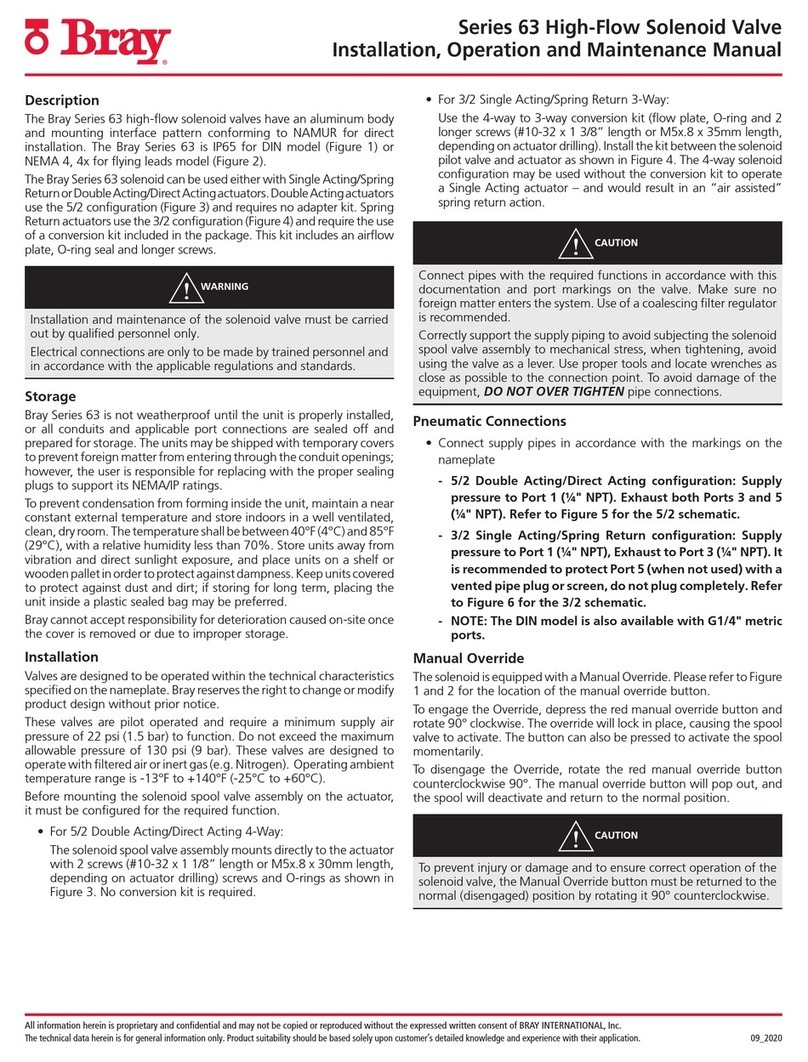
Bray
Bray 63 Series User manual
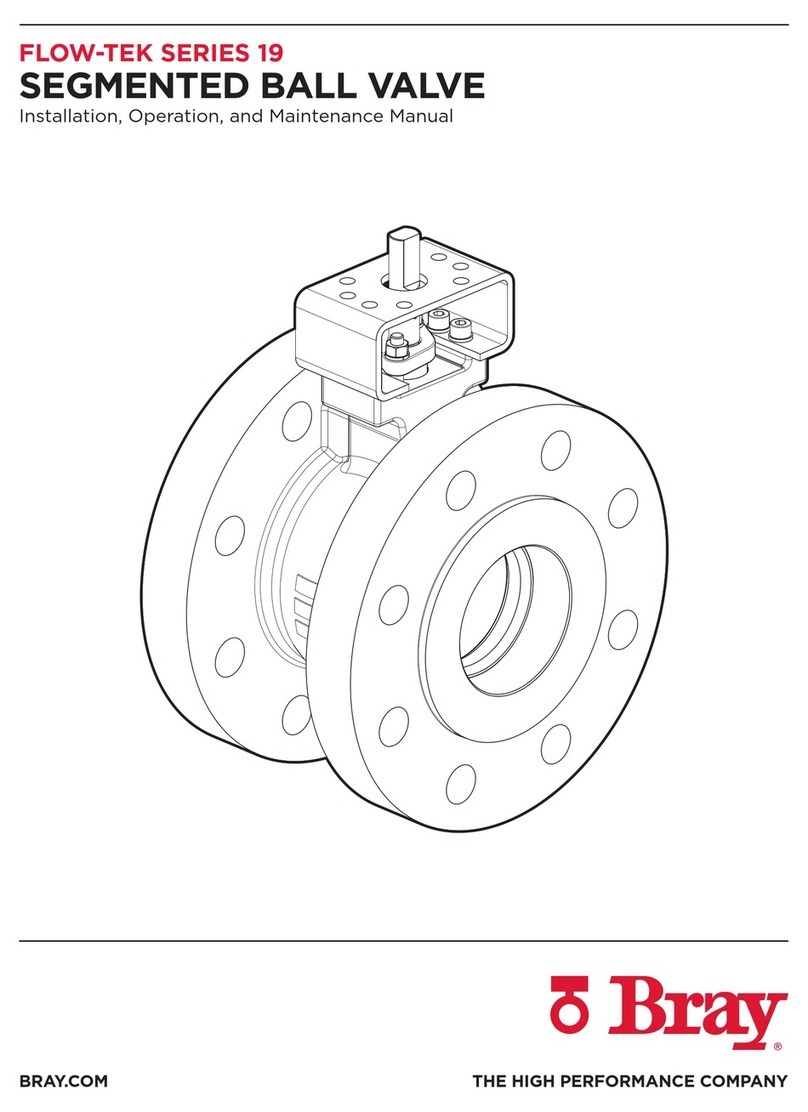
Bray
Bray FLOW-TEK 19 Series User manual
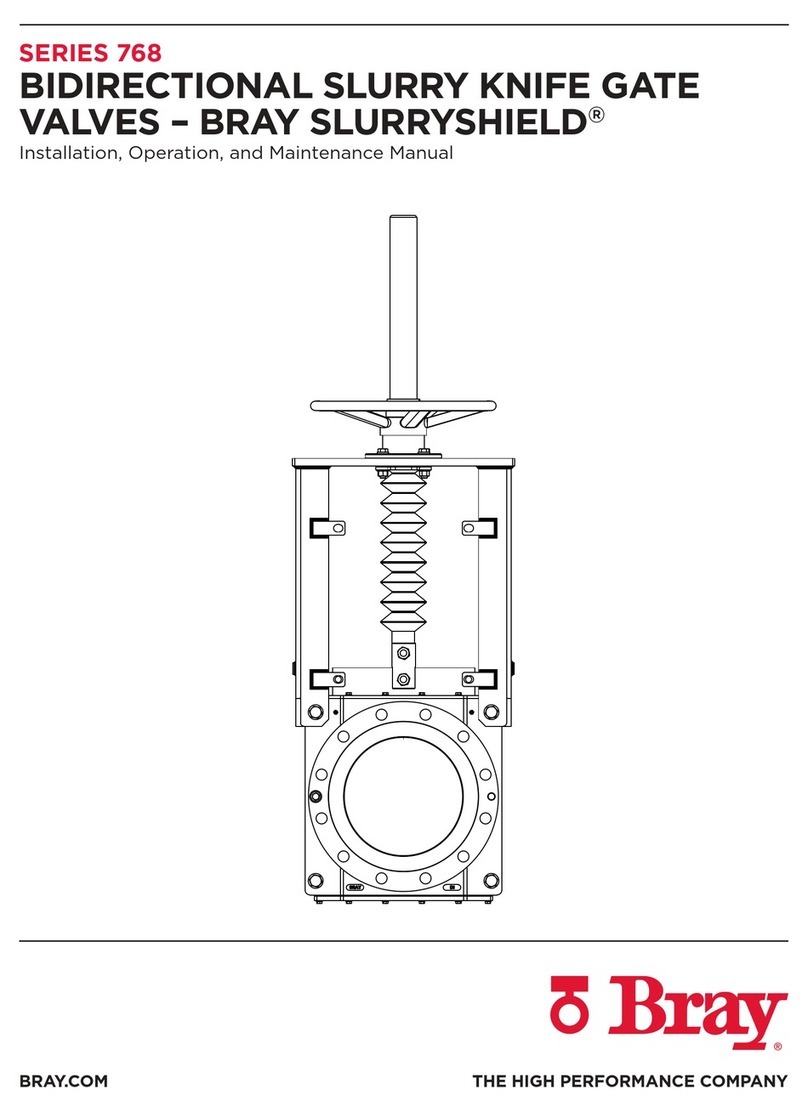
Bray
Bray 768 Series User manual
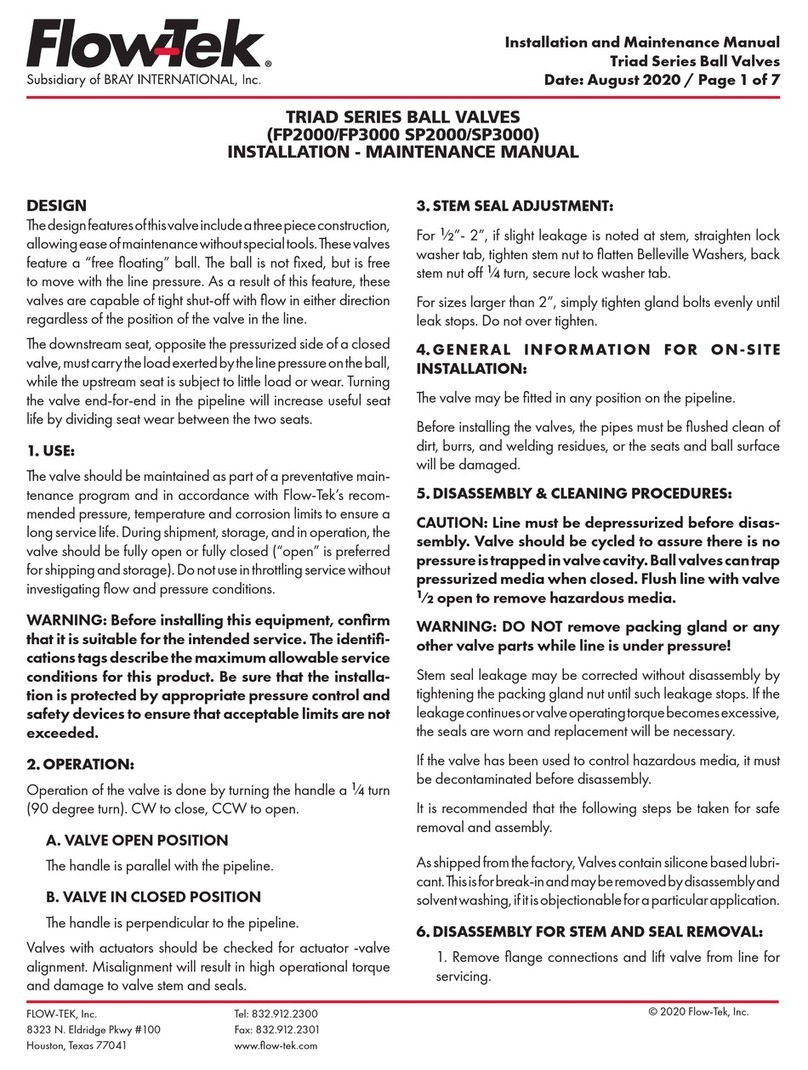
Bray
Bray Flow-Tek Triad Series Instruction Manual
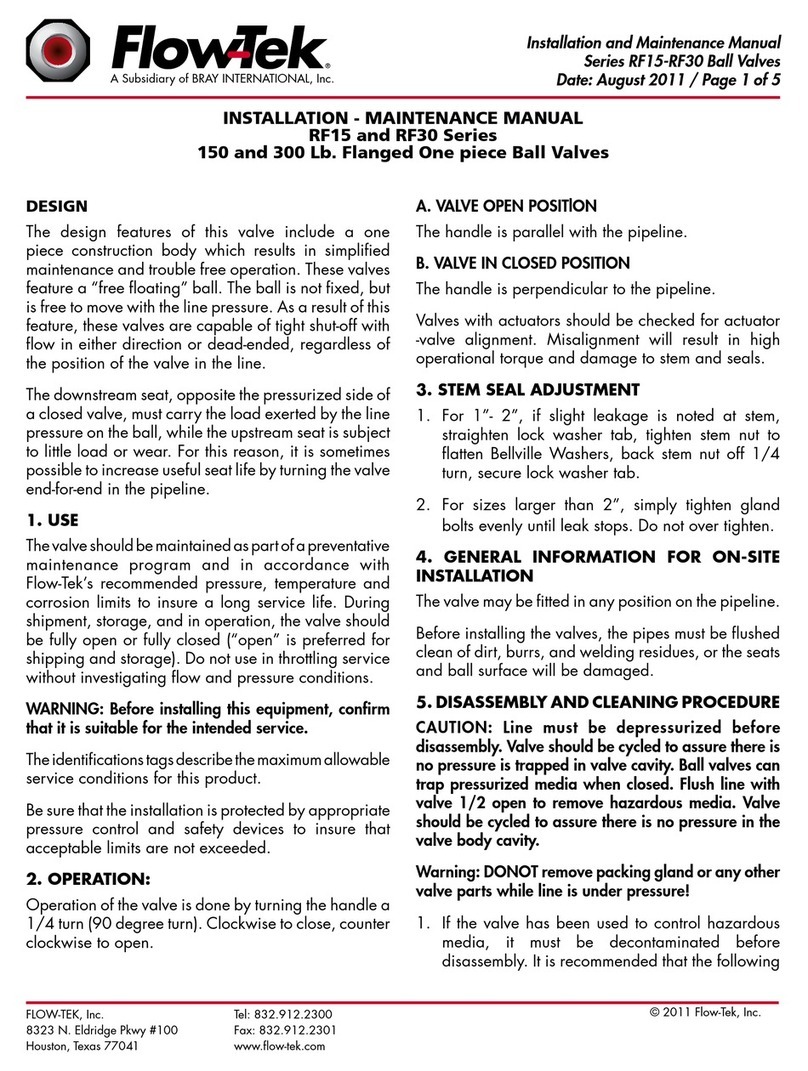
Bray
Bray RF15 Manual
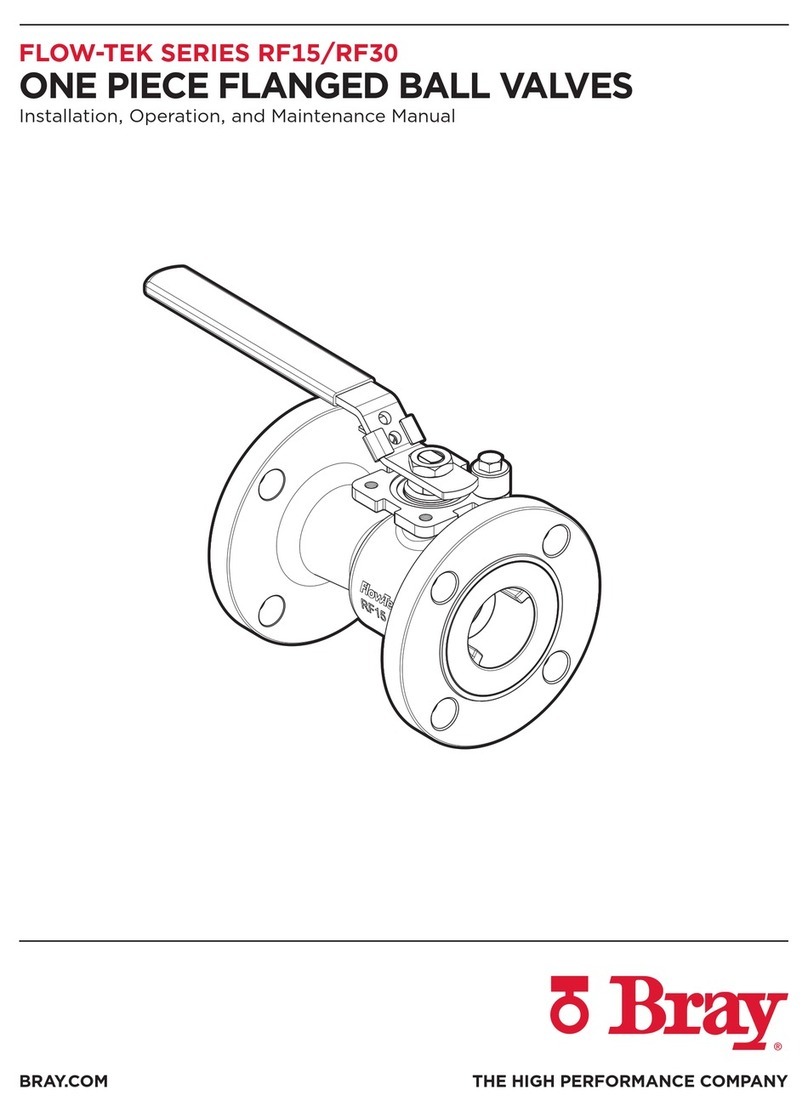
Bray
Bray FLOW-TEK Series User manual
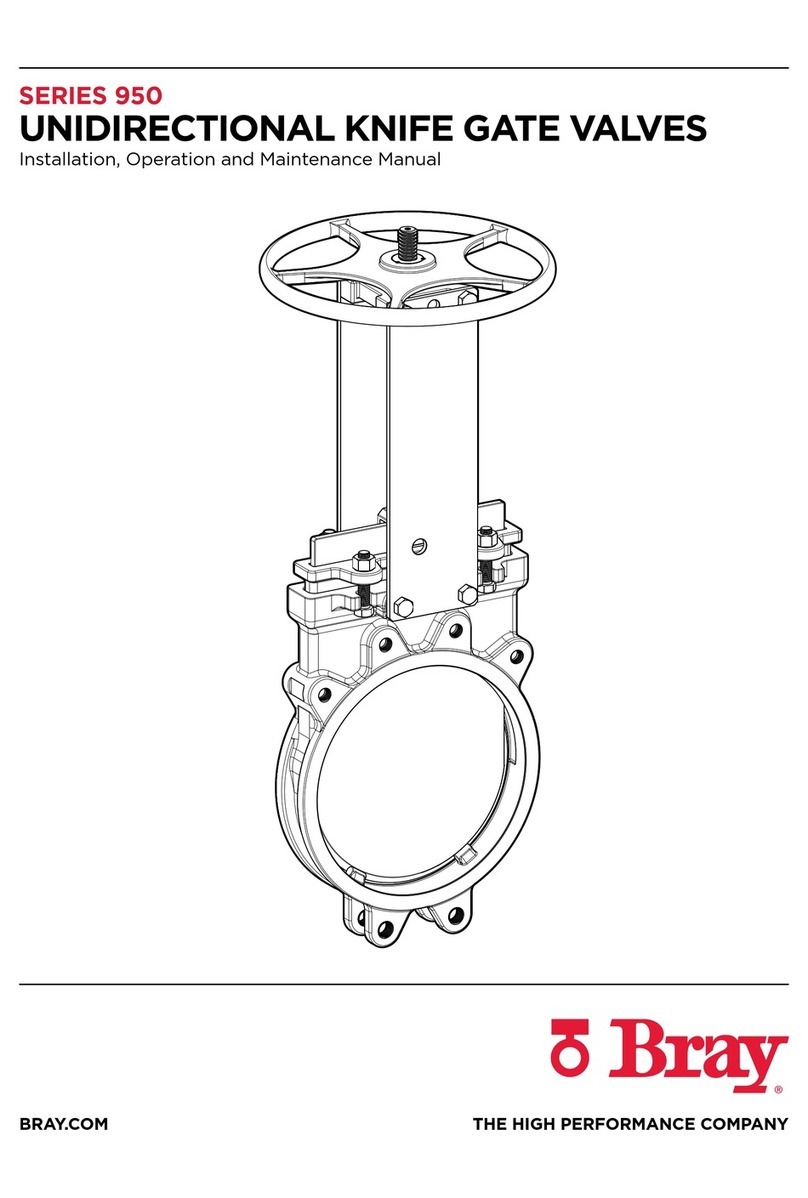
Bray
Bray 950 Series User manual
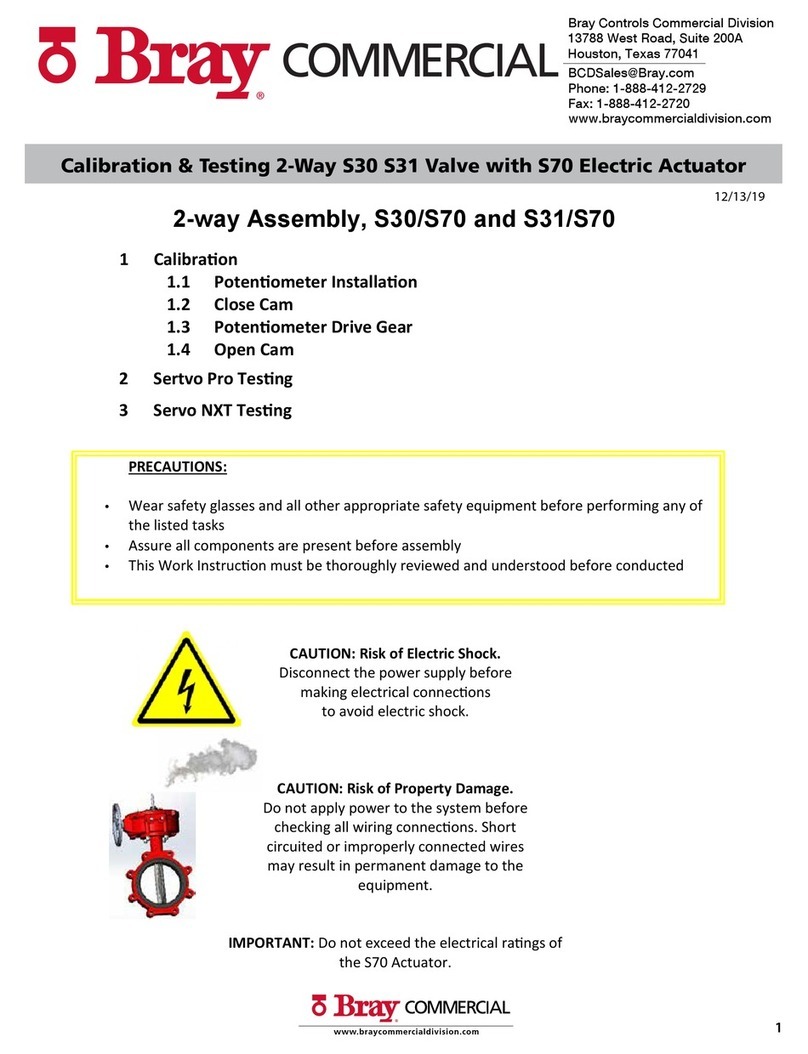
Bray
Bray S30/S70 User manual

Bray
Bray FlowTek F15 Series Manual
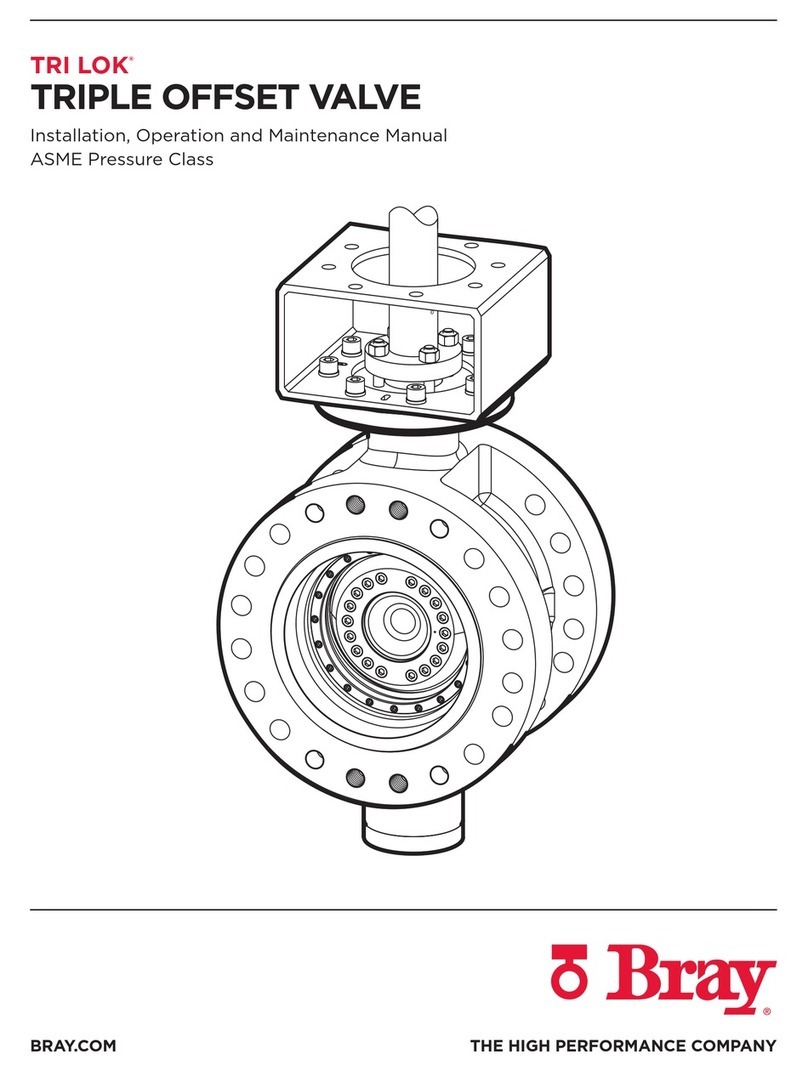
Bray
Bray TRI LOK Series User manual
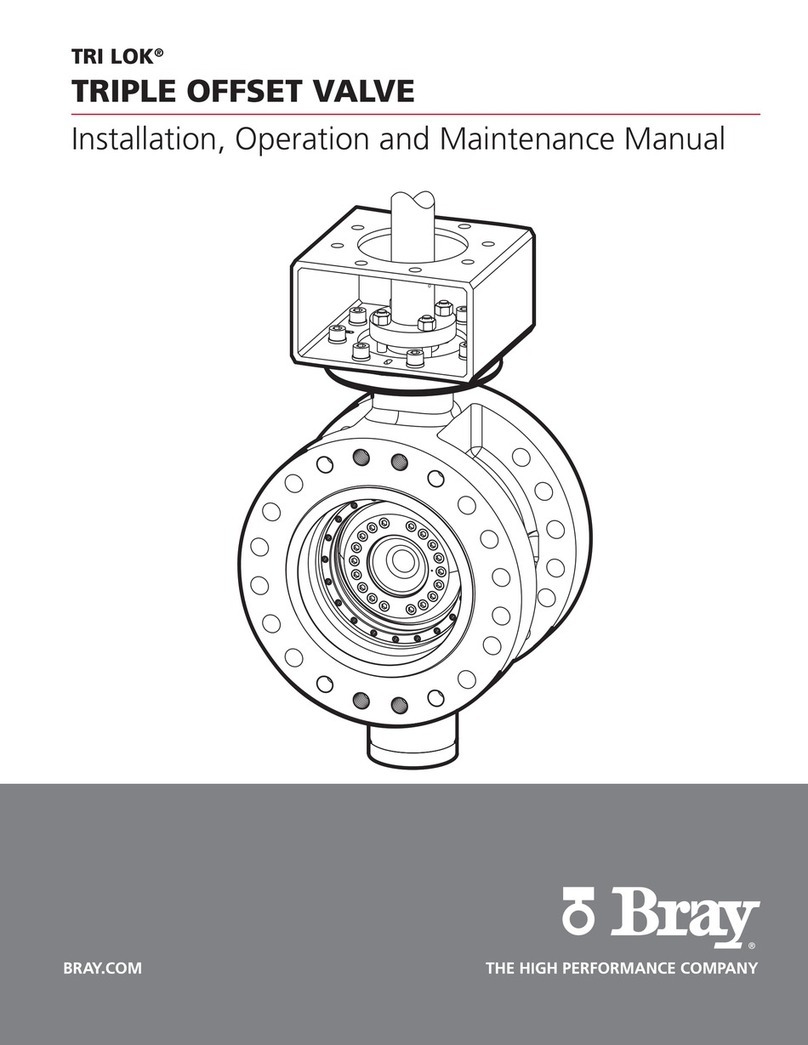
Bray
Bray TRI LOK User manual

Bray
Bray FLOW-TEK Series User manual

Bray
Bray TRI LOK User manual

Bray
Bray TRI LOK Instruction manual

Bray
Bray MCCANNALOK User manual
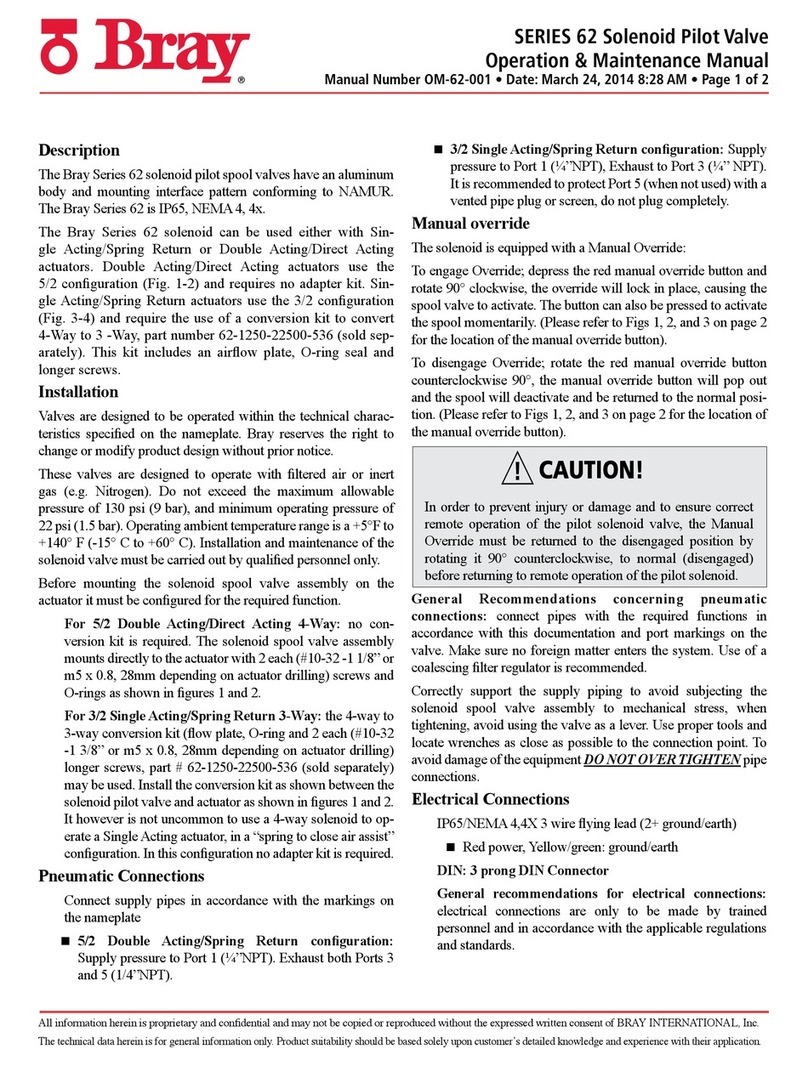
Bray
Bray 62 SERIES Manual
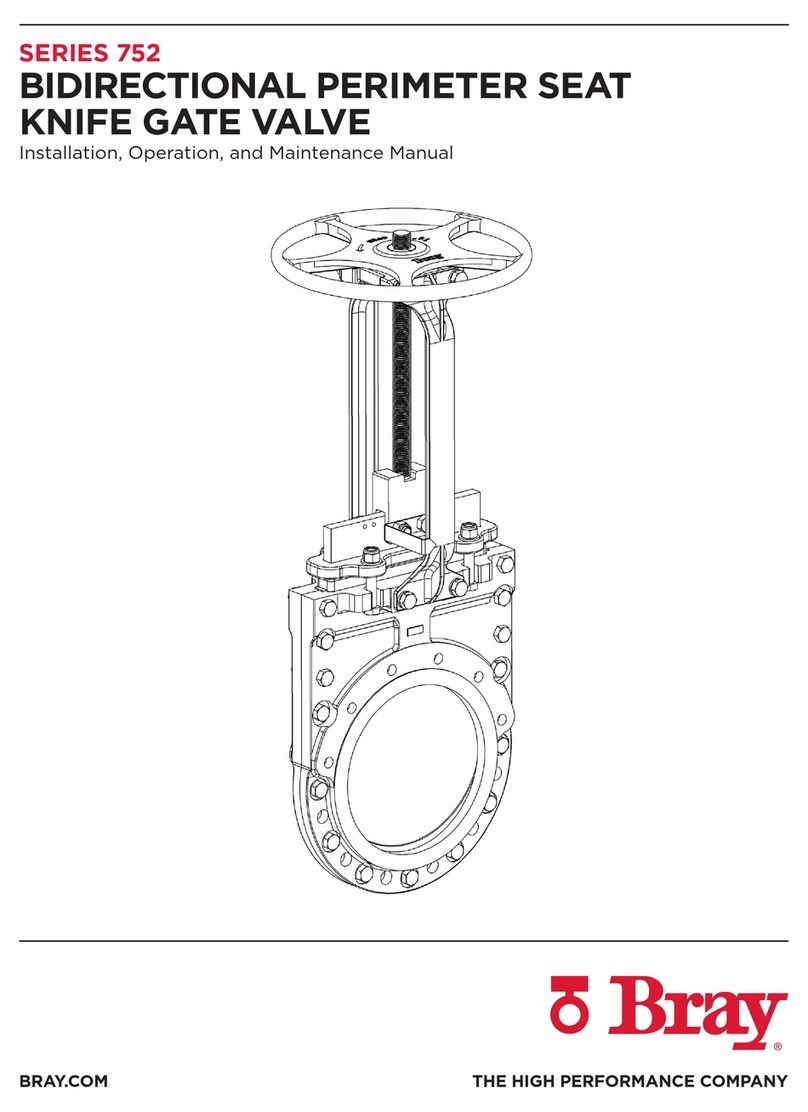
Bray
Bray 752 Series User manual
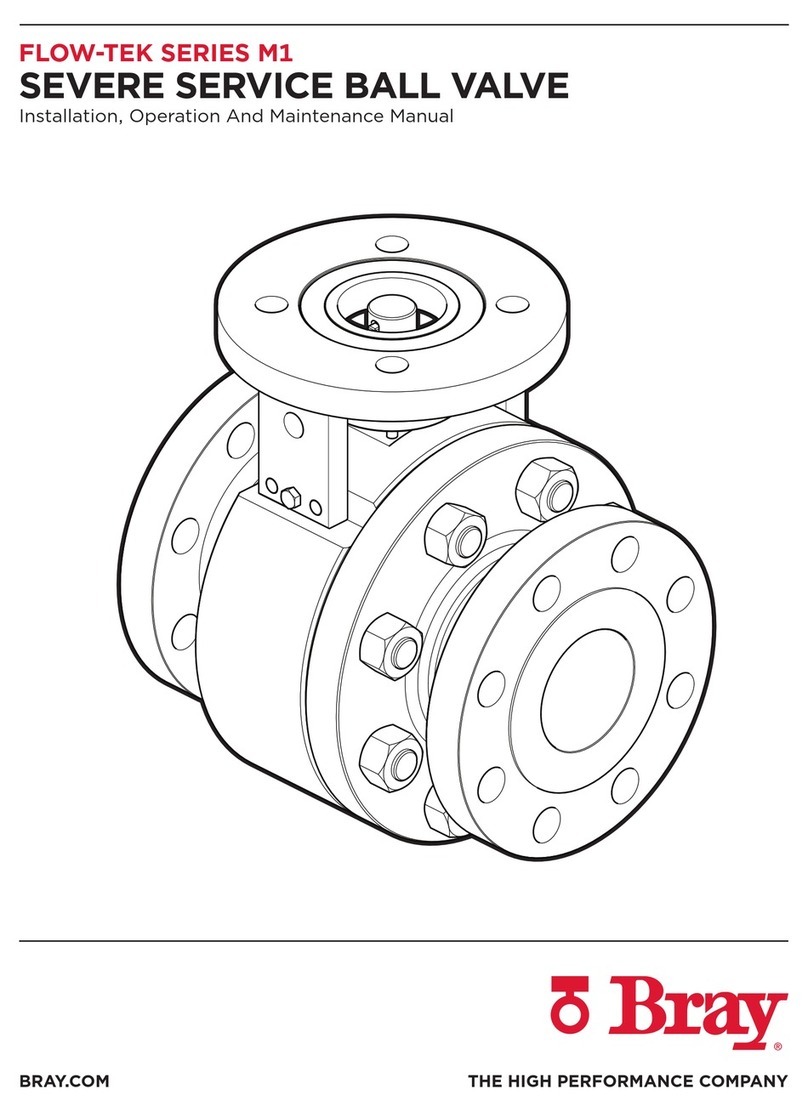
Bray
Bray FLOW-TEK M1 Series User manual

Bray
Bray TRI LOK User manual

Bray
Bray ACRIS 24 Series 24 User manual
